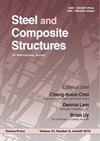波形钢腹板弯曲组合箱梁自由振动试验研究
IF 3.9
3区 工程技术
Q1 CONSTRUCTION & BUILDING TECHNOLOGY
引用次数: 0
摘要
波纹钢腹板弯曲组合箱梁由于其自身的优点和道路线形的要求,在桥梁中得到了广泛的应用,但其曲率使其静动力性能更加复杂。为了研究带csw的弯曲CBGs的自由振动性能,以跨径比(n=L/R)、箱形截面单元数和隔板数为参数,设计了5根简支梁试验梁。实验中测量了其固有频率和模态振型。利用ANSYS软件将实验结果与数值结果进行了比较,得到了满意的结果。参数化分析表明,对于带csw的弯曲CBG,其纵向模态振型是弯曲和扭转相结合的,且扭转效应对模态振型和频率的贡献随着n的增大而增大,导致纵向和横向频率减小,扭转频率增大。钢腹板的波纹角对带csw的弯曲CBGs的固有频率影响不大。增加钢腹板厚度和隔板数量可以有效提高带csw的弯曲CBG的扭转刚度;而桥面宽度对横向刚度的影响较大。本文章由计算机程序翻译,如有差异,请以英文原文为准。
Experimental research on free vibration of curved composite box-girders with corrugated steel webs
The curved composite box-girders (CBGs) with corrugated steel webs (CSWs) have been used widely in bridges due to their great advantages and the demand of the road alignment, but the curvature makes both the static and dynamic behaviors more complex. To research the free vibration performance of the curved CBGs with CSWs, 5 simply-supported test girders were designed with the span-to-radius ratio (n=L/R), the number of the cells of the box section, and the number of the diaphragms as parameters. The natural frequencies and mode shapes were measured in the experiment. The experimental results were compared with the numerical results using ANSYS software, and a satisfying agreement was obtained. The parametric analysis shows that for the curved CBG with CSWs, the vertical mode shapes are combined flexural and torsion, and the contribution of the torsional effects to the mode shapes and frequencies improve with the increase of n, which leads to a decrease in the vertical and lateral frequencies and increase in the torsional frequency. The corrugated angle of the steel web has little effect on the natural frequencies of the curved CBGs with CSWs. Increasing the thickness of the steel web and the number of the diaphragms can improve the torsional rigidity of the curved CBG with CSWs effectively; while the deck width has a great contribution on the lateral rigidity.
求助全文
通过发布文献求助,成功后即可免费获取论文全文。
去求助
来源期刊

Steel and Composite Structures
工程技术-材料科学:复合
CiteScore
8.50
自引率
19.60%
发文量
0
审稿时长
7.5 months
期刊介绍:
Steel & Composite Structures, An International Journal, provides and excellent publication channel which reports the up-to-date research developments in the steel structures and steel-concrete composite structures, and FRP plated structures from the international steel community. The research results reported in this journal address all the aspects of theoretical and experimental research, including Buckling/Stability, Fatigue/Fracture, Fire Performance, Connections, Frames/Bridges, Plates/Shells, Composite Structural Components, Hybrid Structures, Fabrication/Maintenance, Design Codes, Dynamics/Vibrations, Nonferrous Metal Structures, Non-metalic plates, Analytical Methods.
The Journal specially wishes to bridge the gap between the theoretical developments and practical applications for the benefits of both academic researchers and practicing engineers. In this light, contributions from the practicing engineers are especially welcome.
 求助内容:
求助内容: 应助结果提醒方式:
应助结果提醒方式:


